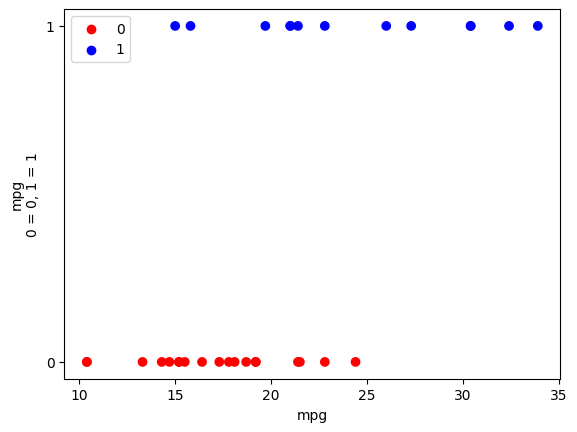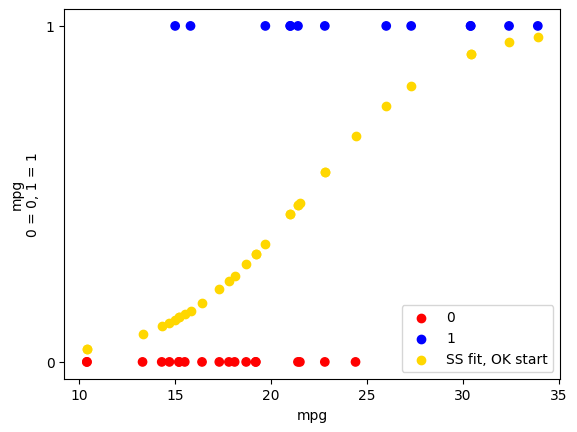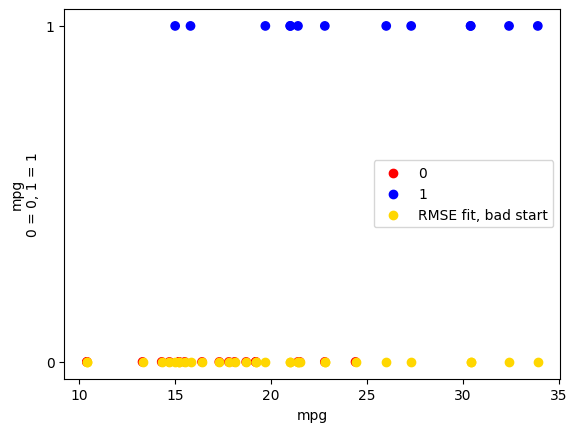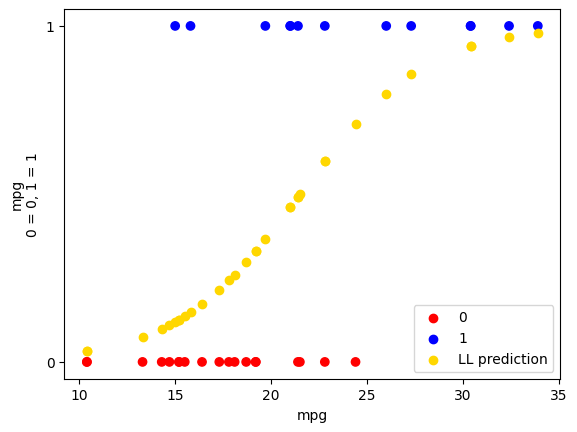Logistic regression can fail with root mean squares#
Show code cell content
import numpy as np
import pandas as pd
pd.set_option('mode.copy_on_write', True)
import matplotlib.pyplot as plt
from scipy.optimize import minimize
We read in the mtcars dataset that will be very familiar to users of R:
mtcars = pd.read_csv('mtcars.csv')
mtcars.head()
| mpg | cyl | disp | hp | drat | wt | qsec | vs | am | gear | carb | |
|---|---|---|---|---|---|---|---|---|---|---|---|
| 0 | 21.0 | 6 | 160.0 | 110 | 3.90 | 2.620 | 16.46 | 0 | 1 | 4 | 4 |
| 1 | 21.0 | 6 | 160.0 | 110 | 3.90 | 2.875 | 17.02 | 0 | 1 | 4 | 4 |
| 2 | 22.8 | 4 | 108.0 | 93 | 3.85 | 2.320 | 18.61 | 1 | 1 | 4 | 1 |
| 3 | 21.4 | 6 | 258.0 | 110 | 3.08 | 3.215 | 19.44 | 1 | 0 | 3 | 1 |
| 4 | 18.7 | 8 | 360.0 | 175 | 3.15 | 3.440 | 17.02 | 0 | 0 | 3 | 2 |
This dataset has one row per make and model of car. The columns have various measures and other information about each make and model.
The columns we are interested in here are:
mpg: Miles/(US) gallonam: Transmission (0 = automatic, 1 = manual)
Notice that am is already numeric, and so is already a dummy variable.
mpg = mtcars['mpg']
am_dummy = mtcars['am']
We will try to predict whether the car has an automatic transmission (column
am) using the miles per gallon measure (column mpg).
Here is a plot of the am values against the mpg values:
Show code cell content
# Code to make nice plots for binary columns. Please ignore.
def plot_binary(df, x_name, bin_name, bin_labels=(0, 1),
color_names=('red', 'blue')):
x_vals = df[x_name]
bin_vals = df[bin_name]
# Build plot, add custom label.
dummy = bin_vals.replace(bin_labels, (0, 1))
colors = bin_vals.replace(bin_labels, color_names)
plt.scatter(x_vals, dummy, c=colors)
plt.xlabel(x_name)
plt.ylabel('%s\n0 = %s, 1 = %s' % (x_name, bin_labels[0], bin_labels[1]))
plt.yticks([0, 1]); # Just label 0 and 1 on the y axis.
# Put a custom legend on the plot. This code is a little obscure.
plt.scatter([], [], c=color_names[0], label=bin_labels[0])
plt.scatter([], [], c=color_names[1], label=bin_labels[1])
Show code cell content
plot_binary(mtcars, 'mpg', 'am')
plt.legend();

We need our machinery for calculating the inverse logit transformation, converting from the log-odds-ratio straight line prediction to the sigmoid prediction.
def inv_logit(y):
""" Reverse logit transformation
"""
odds_ratios = np.exp(y) # Reverse the log operation.
return odds_ratios / (odds_ratios + 1) # Reverse odds ratios operation.
def params2pps(intercept, slope, x):
""" Calculate predicted probabilities of 1 for each observation.
"""
# Predicted log odds of being in class 1.
predicted_log_odds = intercept + slope * x
return inv_logit(predicted_log_odds)
This is our simple sum of square cost function comparing the sigmoid p predictions to the 0 / 1 labels
def rmse_logit(c_s, x_values, y_values):
# Unpack intercept and slope into values.
intercept, slope = c_s
# Predicted p values on sigmoid
pps = params2pps(intercept, slope, x_values)
# Prediction errors.
sigmoid_error = y_values - pps
# Root mean squared error
return np.sqrt(np.mean(sigmoid_error ** 2))
We run minimize using some (it turns out) close-enough initial values for the log-odds intercept and slope:
# Guessed log-odds intercept slope of -5, 0.5
mr_rmse_ok = minimize(rmse_logit, [-5, 0.5], args=(mpg, am_dummy))
mr_rmse_ok
message: Optimization terminated successfully.
success: True
status: 0
fun: 0.39143665337028305
x: [-6.164e+00 2.819e-01]
nit: 16
jac: [ 1.863e-08 2.533e-07]
hess_inv: [[ 4.949e+02 -2.326e+01]
[-2.326e+01 1.122e+00]]
nfev: 72
njev: 24
The prediction sigmoid looks reasonable:
inter_ok, slope_ok = mr_rmse_ok.x
predicted_ok = inv_logit(inter_ok + slope_ok * mpg)
Show code cell content
plot_binary(mtcars, 'mpg', 'am')
plt.scatter(mpg, predicted_ok, c='gold', label='SS fit, OK start')
plt.legend();

But - if we start with a not-so-close initial guess for the intercept and
slope, minimize gets terribly lost:
# Guessed log-odds intercept slope of 1, 1
mr_rmse_not_ok = minimize(rmse_logit, [1, 1], args=(mpg, am_dummy))
mr_rmse_not_ok
message: Optimization terminated successfully.
success: True
status: 0
fun: 0.6373774391990981
x: [ 6.641e-01 -2.562e+00]
nit: 1
jac: [ 0.000e+00 0.000e+00]
hess_inv: [[1 0]
[0 1]]
nfev: 33
njev: 11
The prediction sigmoid fails completely:
inter_not_ok, slope_not_ok = mr_rmse_not_ok.x
predicted_not_ok = inv_logit(inter_not_ok + slope_not_ok * mpg)
Show code cell content
plot_binary(mtcars, 'mpg', 'am')
plt.scatter(mpg, predicted_not_ok, c='gold', label='RMSE fit, bad start')
plt.legend();

Can we do better with the maximum likelihood estimate (MLE) cost function?
def logit_reg_cost(intercept_and_slope, x, y):
""" Cost function for maximum likelihood
"""
intercept, slope = intercept_and_slope
pp1 = params2pps(intercept, slope, x)
p_of_y = y * pp1 + (1 - y) * (1 - pp1)
log_likelihood = np.sum(np.log(p_of_y))
return -log_likelihood
Here we pass some absolutely terrible initial guesses for the intercept and slope:
mr_LL = minimize(logit_reg_cost, [10, -5], args=(mpg, am_dummy))
mr_LL
message: Optimization terminated successfully.
success: True
status: 0
fun: 14.837583824119367
x: [-6.604e+00 3.070e-01]
nit: 13
jac: [-2.384e-07 -4.172e-06]
hess_inv: [[ 5.538e+00 -2.659e-01]
[-2.659e-01 1.330e-02]]
nfev: 57
njev: 19
The fit is still reasonable:
inter_LL, slope_LL = mr_LL.x
predicted_LL = inv_logit(inter_LL + slope_LL * mpg)
plot_binary(mtcars, 'mpg', 'am')
plt.scatter(mpg, predicted_LL, c='gold', label='LL prediction')
plt.legend();

As we have seen before, the MLE fit above is the same algorithm that Statmodels and other packages use.
import statsmodels.formula.api as smf
model = smf.logit('am ~ mpg', data=mtcars)
fit = model.fit()
fit.summary()
Optimization terminated successfully.
Current function value: 0.463674
Iterations 6
| Dep. Variable: | am | No. Observations: | 32 |
|---|---|---|---|
| Model: | Logit | Df Residuals: | 30 |
| Method: | MLE | Df Model: | 1 |
| Date: | Wed, 05 Jun 2024 | Pseudo R-squ.: | 0.3135 |
| Time: | 16:10:51 | Log-Likelihood: | -14.838 |
| converged: | True | LL-Null: | -21.615 |
| Covariance Type: | nonrobust | LLR p-value: | 0.0002317 |
| coef | std err | z | P>|z| | [0.025 | 0.975] | |
|---|---|---|---|---|---|---|
| Intercept | -6.6035 | 2.351 | -2.808 | 0.005 | -11.212 | -1.995 |
| mpg | 0.3070 | 0.115 | 2.673 | 0.008 | 0.082 | 0.532 |
Notice that the intercept and slope coefficients are the same as the ones we found with the MLE cost function and minimize.


